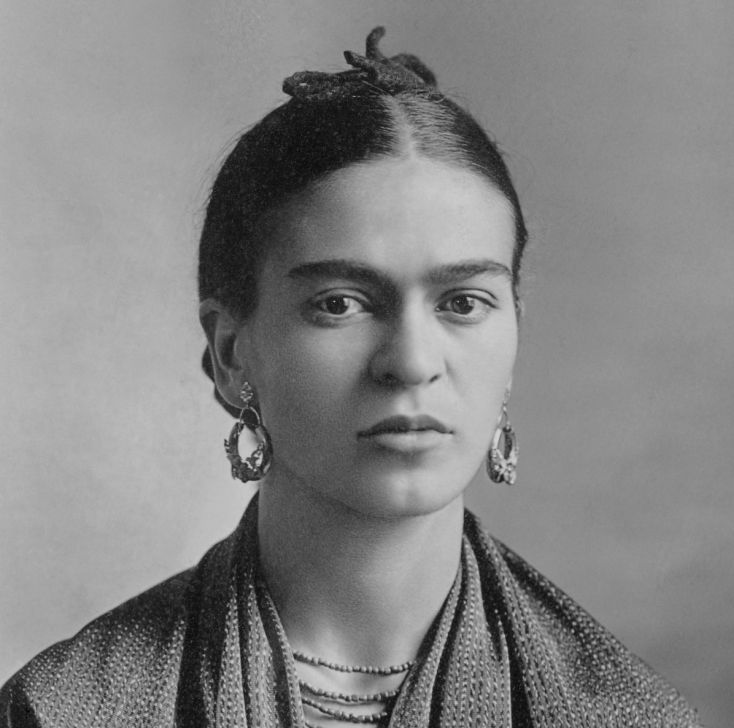
Frida Kahlo: Painter, Pioneer of Emancipation, Cult Figure
Frida Kahlo (1907 – 1954) has succeeded, as one of the few artists from Latin America, in gaining recognition worldwide. Her work oscillates between Surrealism and the real world, largely documenting her own vibrant biography.
Kahlo, the daughter of a German photographer and a Mexican painter, struggled with serious health problems for a long time. At the same time, she loved life, had affairs with other men and women alongside her marriage to the painter Diego Rivera, frequently broke social taboos such as drinking alcohol and smoking in public, and presented herself confidently and emancipated.
Frida Kahlo died at the age of only 47, but both her artistic work and her unyielding character made her an icon of Latin American art and an inspiring figure for women around the world.
Painting as a Remedy
Kahlo's artistic career was closely linked to her history of illness. At the age of six, she contracted polio, which resulted in a shortened leg. As an 18-year-old, she barely survived a traffic accident and was c bedridden for months. As a result of the accident, she was unable to have children, and in the following years, she had to undergo over thirty operations and struggled with chronic pain throughout her life.
However, her long bedridden periods ultimately led her to engage in painting, finding distraction and solace in it. In order to paint while lying down, she had a special easel constructed that hung above her bed. To paint was like an escape from reality for Frida Kahlo. Here she found comfort, processed her suffering, and forgot her pain: "I am not dead and I have a reason to live. That reason is painting."
Kahlo’s Style and Motifs: Surreal Worlds and Self-Portraits
Frida Kahlo's biography directly influenced the choice of her motifs. In many of her paintings, she incorporated both her history of illness and her marriage to the painter Diego Rivera, as well as social and political themes. In over a third of her works, she made herself the subject of the painting: "I paint self-portraits because I am so often alone because I am the person I know best."
Other subjects included still lifes, street scenes, animals, and fantastic and surreal moments, in which she always included elements typical of her Mexican homeland and culture. After suffering a miscarriage in 1932, Kahlo reflected on societal taboos such as childbirth or the loss of a child in her paintings. Her portrayal was based on the realistic forms of objects, but she often exaggerated her scenes into the realm of the fantastic and concluded them with bizarre visual compositions. Her style is often described as New Objectivity, Dadaism, and above all, Surrealism. There is no doubt that there are many parallels to Surrealism, but Kahlo always refused to be labelled as a Surrealist: "They thought I was a Surrealist, but I wasn't. I never painted dreams. I painted my own reality."
Frida Kahlo in Museums Around the World - Then and Now
During Kahlo's lifetime, museums around the world initially paid little attention to her body of work. The first major recognition in Europe came in 1938 when her paintings were exhibited in Paris. In the following years, she participated in group exhibitions worldwide, including Mexico City, New York, and San Francisco.
However, her first major solo exhibition in her home country of Mexico did not take place until 1953. Frida Kahlo's work gained much greater recognition around three decades after her death. Starting with an exhibition at the Whitechapel Gallery in London in 1982, interest in her work grew. Today, the life of the Mexican icon captivates audiences around the world. Although exhibitions are difficult to organise due to her husband Diego Rivera's stipulation that a large portion of her collection, which consists of only 144 oil paintings, should not leave Mexico, regular exhibitions of Frida Kahlo's works and her biography take place on every continent. Examples include the Portland Art Museum (2022), Fondation Beyeler in Basel (2022), Schirn Frankfurt (2020), Denver Art Museum (2021), and London's Victoria and Albert Museum (2018).
Posthumous Pop Star: Celebrated in Hollywood and Auction Houses
Frida Kahlo is more present on the cultural scene today than ever before. In addition to numerous exhibitions, her biography is also referenced in popular culture. She is celebrated as a pioneer of the feminist movement and an iconic figure of Mexican culture. A veritable merchandising market has developed around her persona. Her image has been used for products such as a Barbie doll and an emoji.
In 2002, her life story was adapted into a Hollywood film starring Salma Hayek. Her worldwide popularity is also reflected in auction sales. One of her self-portraits was sold for around 35 million dollars in an auction in New York in 2021, making it the most expensive artwork fromLatin America.
